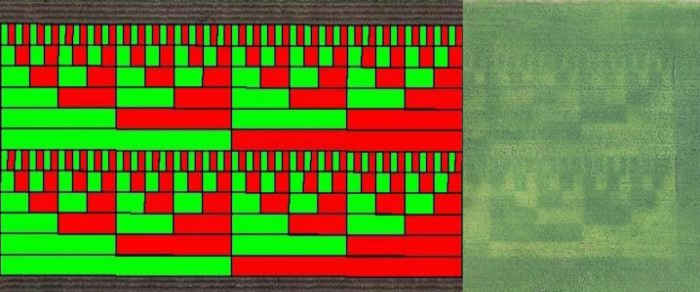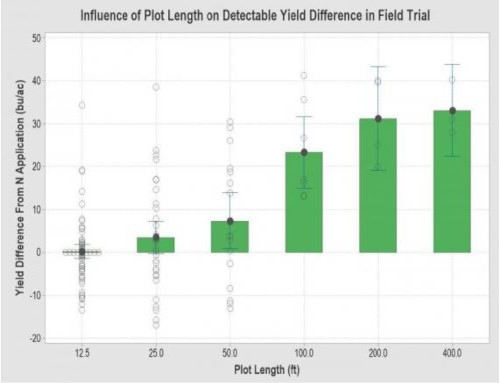By Ryan Bergman
If you are planning on conducting field trials this growing season, how you set up the field trial can determine the accuracy of your yield data at harvest. To reap the full benefits of gathering yield data to improve crop management and influence input decisions, it should be part of your management plan year-round.
Minimum Harvest Length Requirement for Field Trial Comparisons
On average, it takes about 13 seconds for grain to get from the combine head to the mass flow sensor, which means a large amount of grain is averaged together to create a yield data point. As ground speed and header width increase, this delay is also increased. With a 40-foot grain header traveling at 2.5 miles per hour, grain from about 19 feet of forward travel distance is being merged to create a single data point. As speed increases to 4.5 miles per hour, the distance increases to 34 feet of forward travel distance.
Given this delay in crop flow, a common question is how small of an area can be trusted in a yield map during analysis. While some farming equipment has continued to become more precise (planters and sprayers, for example), yield monitor precision has decreased as combine headers have gotten larger. Larger heads are desired for increased capacity, but because they average crop yield from a larger area, the precision and accuracy of yield data is decreased.
The Digital Ag team at Iowa State University set up a field trial to determine the minimum scale for detectable differences in field treatments. The trial was based on a corn nitrogen experiment that was highly likely to result in different yields between the treatments. Fifty pounds of nitrogen were applied to the entire field before planting. Plots of varying lengths from 12.5 feet to 400 feet were sidedressed with an additional 150 pounds of nitrogen (Figure 2).
Mid-season nitrogen stress was visible in aerial imagery in plots that received no sidedress, and a significant difference in yield between the two areas was expected (Figure 1). The field was harvested continuously with the combine passing through sequential high and low yielding zones. Yield data was analyzed based on the nitrogen treatment patterns and by varying treatment lengths to measure differences in corn yield.

Figure 1. Treatment plots with lengths of 12.5 feet, 25 feet, 50 feet, 100 feet, 200 feet and 400 feet were created to measure the minimum treatment size to maintain accurate yield data. The width of each block is 30 feet. Green areas received the 50 lbs. pre-plant plus 150 lbs. sidedressed and red blocks only received the 50 lbs. pre-plant.
Yield data was analyzed by comparing the difference in neighboring nitrogen treatment zones. While we would expect there to be a positive yield difference in the nitrogen rich strips, this was not always the case. Specifically, in the short treatment strips, the grain flow from the high and low nitrogen treatments was mixed within the combine harvesting process and no measurable yield difference was detected. A plot length of 100 feet was required to achieve a statistically significant non-zero yield difference between the nitrogen treatments (Figure 2). The difference was consistent and most pronounced when using plot lengths of 200 feet or greater.

Figure 2. A plot size of 12.5 feet showed no difference in yield between the two treatment areas, while the 400-foot plot showed a difference of more than 30 bushels per acre.
With very small areas, the large amount of grain the combine is processing limits the ability to determine differences in the yield data. This is important when you’re changing treatments along the length of a field, but also during hybrid trials when you may be only taking a half width of the combine head or the plot is much shorter than the length of the field.

Figure 3. Normalized yield comparison between two nitrogen treatments implemented based on the length of the treatment strip. At plot lengths less than 100 feet the combine yield monitor is not able to differentiate yield response treatment differences. At 200 feet or greater the combine can consistently measure the treatment response.
These spatial data constraints should be considered when designing field trials for the upcoming season. Experimental trials in strips across the full length of the field are preferred in most cases to provide enough space for the combine to accurately measure treatment results. Experimental blocks can also be used if they are large enough and if the length of travel within the plot is greater than the minimum required length. The use of experimental block designs is necessary in some cases, like test programs in soybeans where the crop is harvested at a different angle than it was planted. If using this design, a minimum block size of two acres or greater is recommended.
Source : iastate.edu